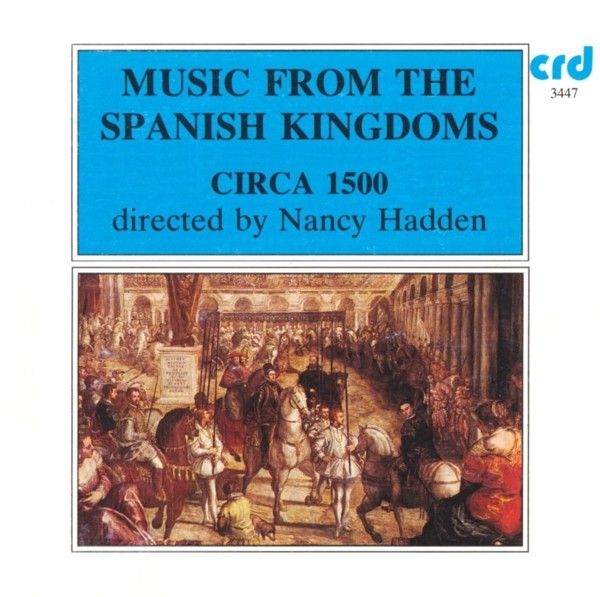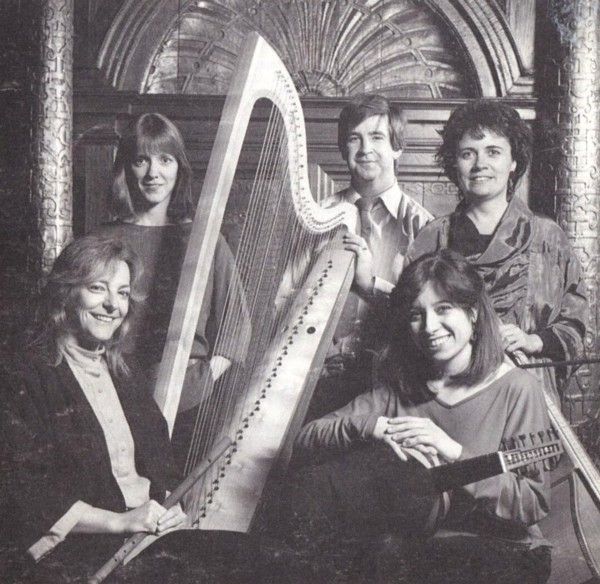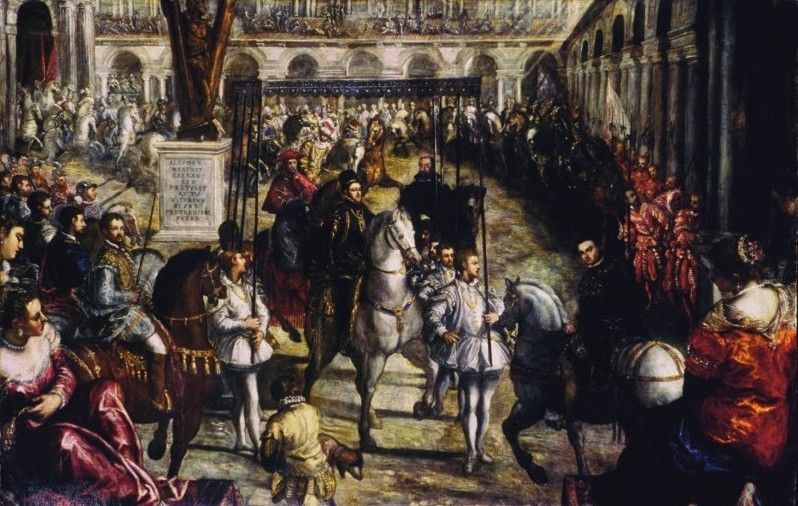Music from the Spanish Kingdoms
Circa 1500

medieval.org
CRD 3447
1989
1. Juan del ENCINA (1468-1529). Oy comamos y bebamos [1:47]
2. Tres morillas me enamoran [1:26]
3. Alonso HERNÁNDEZ (fl. early 16th c.). Tres moricas me enamoran
[4:10]
4. Gagliarda, mi racomando [0:57]
5. Gagliarda, lombarda [1:02]
6. Gagliarda, el tu tu [1:17]
7. Adrian WILLAERT (1480-1562). Vacchie letrose [1:38]
8. Marchetto CARA (1465-1525). Liber fui un tempo in foco [3:35]
9. Francesco da MILANO (1497-1543). La Spagna
[2:16]
10. Bartolomeo TROMBONCINO (1470-1585). Come haro donque ardire
[3:02]
11. Alonso MUDARRA (1508-1580). Tiento para harpa
[0:40]
12. Juan VÁSQUEZ (1500-1560). En la fuente de un rosel [1:54]
set by Diego PISADOR (1509-1557)
13. JOSQUIN (c. 1440-1521). Ile fantazies de Joskin
[2:02]
14. Loyset COMPÈRE (d. 1518). Scaramella [1:16]
15. Johannes MARTINI (1440-1497). Fuge la morte
[2:12]
16. Juan del ENCINA. Entra mayo y sale abril [1:22]
17. Gentil dama [2:39]
18. Juan del ENCINA. Más vale trocar [1:39]
19. Juan del ENCINA. Ay triste que vengo [1:30]
20. Si habéis dicho, marido [1:21]
21. Diego ORTIZ (c. 1510-1570). Ricercar [1:51]
22. Diego ORTIZ. O felici occhi mei
[2:23]
23. Giovan Thomas di MAIO (d. 1563). O trezze bionde anci capelli d'oro
[4:49]
24. Miguel FUENLLANA (1525-1585). Fantasia sexta
[1:53]
25. Sagaleja del Casar [1:04]
26. Diego ORTIZ. Passamezzo moderno
[2:48]
27. Johannes MARTINI. Cayphas [2:18]
28. Giovan Thomas di MAIO. Tutte le vecchie son maleciose
[2:23]
29. ALONSO [Hernández?]. La tricotea
[1:35]
30. Juan del ENCINA. Si habrá en este baldrés
[2:12]
Circa 1500
Nancy Hadden
Nancy Hadden, flute, recorder & crumhom
Emily Van Evera, soprano
Erin Headley, viola da gamba, lirone & fiddle
Paula Chateauneuf, lute & renaissance guitar
Andrew Lawrence-King, Gothic harp, Spanish harp & psaltery
Produced and Engineered by Nicholas Parker
Recorded at West Dean College, nr. Chichester, Sussex
on November 10th-12th 1987

Throughout the Middle Ages the rulers of east-coast Spain — the
kings of Aragon and counts of Barcelona — had looked across the
Mediterranean and longed for a foothold in Italy. It was not, however,
until 1442 when Alfonso the Magnanimous (d. 1458) defeated Rene of
Anjou, his French rival for the kingdom of Naples, that such ambitions
were fulfilled. Alfonso transferred his court to Naples and it
automatically became a meeting-point for Hispanic and Italian culture;
and from this time, sometimes referred to as the Neapolitan 'Golden
Age', a tradition for musical exchange between Spain and Naples was
established that was to last for several centuries.
Documentary evidence shows that music, both sacred and secular, works
of musical theory, musical instruments as well as the singers and
instrumentalists themselves travelled back and forth across the
Mediterranean from the reign of Alfonso onwards. An important figure in
the transmission of musical repertory in this way was undoubtedly the
Spanish-born Johannes de Cornago who served both at the Neapolitan
court of Alfonso and his illegitimate son and heir Ferrante I (d.
1494), and at the Aragonese court of Ferdinand of Aragon (d. 1516) in
Spain. His name appears only once in the Aragonese treasury accounts
— in May 1475 — though the fact that the account books are
incomplete for this time makes it difficult to know whether this was a
fleeting visit or an extended sojourn. Either way Cornago's presence in
Spain would account for the inclusion of several of his songs in
manuscript sources closely associated with Ferdinand's court such as
the Cancionero Musical de Palacio.
At the same time, Cornago, or perhaps one of the several other Spanish
singers who served at both courts, would have brought with them some of
the Italian songs preserved in these sources, as well as works by
Josquin and Martini and other Franco-Flemish composers active in Italy.
For in addition to its Spanish connections, the Neapolitan court was in
constant contact with the courts of northern Italy such as Mantua and
Ferrara and the frottole of Cara and Tromboncino were certainly known
there.
Naples, then, was a veritable melting-pot for the musical repertory of
the late 15th century, and even though the splendour of the Neapolitan
court waned after the death of Ferrante in 1494, it continued to fulfil
this role. After a decade of internal strife and conflicting claims to
the Neapolitan crown, Naples fell once more in 1504 under Spanish
dominion so that cultural exchange with the east coast of Spain
continued to flourish well into the Renaissance. Ferdinand himself,
like his uncle Alfonso before him, seems at one point in 1506 to have
envisaged setting up his court in Naples and he stayed there for the
best part of a year. After his death in 1516, his second wife Germaine
de Foix married the Duke of Calabria and their court in Valencia
(traditionally the strongest point of contact with Naples) became one
of the most important musical centres in Spain in the first decades of
the 16th century.
Although little biographical information has come to light for the
vihuelist Luis de Milan, he was clearly closely connected with the
Valencian court for most of his career, and his El Cortesano of
1561 describes in detail the daily life of that court: the hunting, the
games and entertainments, the music-making and the social chit-chat of
a thoroughly renaissance court. Taking as its starting-point
Castiglione's Il Corteggiano, Milan's book bears witness to the
Italian influence that continued to reach Spain primarily via Naples
and that was felt more keenly in Valencia than in any other part of the
Iberian peninsular. The tradition for Spanish musicians making their
careers in Naples was also continued by Diego Ortiz who, born in Toledo
in about 1510, was certainly in Naples by 1553 when he published his Trattado
de glosas, and who served successive Spanish viceroys as maestro
de capilla.
It was perhaps above all in the realm of song that Hispanic and Italian
cultures coincided; in both countries a strong tradition for courtly
song in the vernacular evolved during the second half of the 15th
century, very probably from an existing tradition for improvised song
to a simple lute or vihuela accompaniment as opposed to the tenor-based
contrapuntalism of the Franco-Flemish chanson. The extent to
which these were shared or independent traditions is difficult to
ascertain, but it is clear that the Neapolitan court may have held a
key position in this respect. There are many musical parallels as well
as shared poetic structures between the main song forms of the period
— the frottola and the villancico — not least the infusion
of dance rhythms and the predominance of the melody in the upper part
of three-or four-voice songs supported by strongly directional
harmonies. These features are also to the fore in the villanescha
— a slightly later development of the frottola — of the
Neapolitan composer and organist Giovan Tomas di Maio, who is generally
credited with having evolved this genre. His first volume of
villaneschi was published in Venice in 1546.
©Tess Knighton 1989



